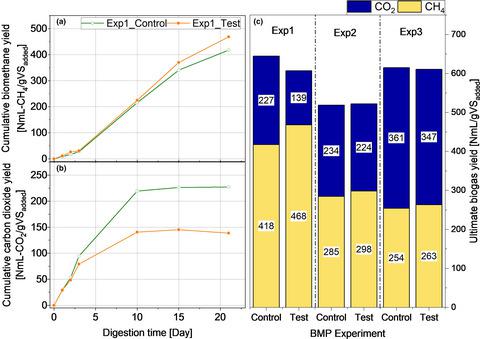当前位置:
X-MOL 学术
›
Food Energy Secur.
›
论文详情
Our official English website, www.x-mol.net, welcomes your
feedback! (Note: you will need to create a separate account there.)
Enhancing bioenergy production from food waste by in situ biomethanation: Effect of the hydrogen injection point
Food and Energy Security ( IF 4.0 ) Pub Date : 2021-05-06 , DOI: 10.1002/fes3.288 Cynthia Kusin Okoro‐Shekwaga 1, 2 , Andrew Ross 3 , Miller Alonso Camargo‐Valero 1, 4
Food and Energy Security ( IF 4.0 ) Pub Date : 2021-05-06 , DOI: 10.1002/fes3.288 Cynthia Kusin Okoro‐Shekwaga 1, 2 , Andrew Ross 3 , Miller Alonso Camargo‐Valero 1, 4
Affiliation

|
The increasing rate of food waste (FW) generation around the world is a growing environmental concern, notwithstanding, its valorisation through anaerobic digestion (AD) makes it a potential resource. Moreover, there is a growing demand to optimise the biomethane from AD for gas-to-grid (GtG) and vehicular applications. This has spurred researches on hydrogen gas (H2) injection into AD systems to enhance the biological conversion of H2 and carbon dioxide (CO2) to methane (CH4), a process known as biomethanation. A simplistic approach for biomethanation is to add H2 directly into working AD reactors (in situ biomethanation). However, a competition for the injected H2 towards other biological reactions besides H2/CO2 conversion to CH4 could follow, thus, reducing the efficiency of the system. Hence, this study was conducted to understand how different H2 injection points would affect H2/CO2 conversion to CH4 during FW in situ biomethanation, to identify an optimal injection point. Experiments were designed using H2 equivalent to 5% of the head-space of the AD reactor at three injection points representing different stages of AD: before volatile fatty acids (VFA) accumulation, during VFA accumulation and at depleted VFA intermediates. Lower potential for competitive H2 consumption before the accumulation of VFA enabled a high H2/CO2 conversion to CH4. However, enhanced competition for soluble substrates during VFA accumulation reduced the efficiency of H2/CO2 conversion to CH4 when H2 was added at this stage. In general, 12%, 4% and 10% CH4 increases as well as 39%, 25% and 34% CO2 removal were obtained for H2 added before VFA accumulation, during VFA accumulation and at depleted VFA intermediates, respectively. For immediate integration of biomethanation with existing AD facilities, it is suggested that the required H2 be obtained biologically by dark fermentation.
中文翻译:

通过原位生物甲烷化提高食物垃圾的生物能源生产:氢气注入点的影响
世界范围内食物垃圾 (FW) 产生的速度不断增加,这是一个日益严重的环境问题,尽管通过厌氧消化 (AD) 对其进行增值使其成为一种潜在的资源。此外,对优化来自 AD 的生物甲烷用于天然气到电网 (GtG) 和车辆应用的需求不断增长。这激发了对将氢气 (H 2 ) 注入 AD 系统以增强 H 2和二氧化碳 (CO 2 ) 向甲烷 (CH 4 )的生物转化的研究,这一过程称为生物甲烷化。生物甲烷化的一种简单方法是将 H 2直接添加到工作的 AD 反应器中(原位生物甲烷化)。然而,对注入的 H 2的竞争除了 H 2 /CO 2转化为 CH 4之外,其他生物反应也会随之发生,从而降低系统的效率。因此,本研究旨在了解不同的 H 2注入点如何影响FW 原位生物甲烷化过程中H 2 /CO 2转化为 CH 4 的过程,以确定最佳注入点。在代表 AD 不同阶段的三个注入点使用相当于 AD 反应器顶部空间 5% 的H 2设计实验:挥发性脂肪酸 (VFA) 积累之前、VFA 积累期间和耗尽的 VFA 中间体。竞争性 H 2 的潜力较低VFA 积累之前的消耗使得 H 2 /CO 2转化为 CH 4 的转化率很高。然而,当在此阶段添加H 2时,VFA 积累过程中对可溶性底物的竞争增强会降低 H 2 /CO 2转化为 CH 4的效率。一般而言,对于在VFA积累之前、在VFA积累期间和在耗尽的VFA中间体添加的H 2分别获得12%、4%和10%的CH 4增加以及39%、25%和34%的CO 2去除。为了立即将生物甲烷化与现有的 AD 设施整合起来,建议将所需的 H 2 通过暗发酵从生物学上获得。
更新日期:2021-05-06
中文翻译:

通过原位生物甲烷化提高食物垃圾的生物能源生产:氢气注入点的影响
世界范围内食物垃圾 (FW) 产生的速度不断增加,这是一个日益严重的环境问题,尽管通过厌氧消化 (AD) 对其进行增值使其成为一种潜在的资源。此外,对优化来自 AD 的生物甲烷用于天然气到电网 (GtG) 和车辆应用的需求不断增长。这激发了对将氢气 (H 2 ) 注入 AD 系统以增强 H 2和二氧化碳 (CO 2 ) 向甲烷 (CH 4 )的生物转化的研究,这一过程称为生物甲烷化。生物甲烷化的一种简单方法是将 H 2直接添加到工作的 AD 反应器中(原位生物甲烷化)。然而,对注入的 H 2的竞争除了 H 2 /CO 2转化为 CH 4之外,其他生物反应也会随之发生,从而降低系统的效率。因此,本研究旨在了解不同的 H 2注入点如何影响FW 原位生物甲烷化过程中H 2 /CO 2转化为 CH 4 的过程,以确定最佳注入点。在代表 AD 不同阶段的三个注入点使用相当于 AD 反应器顶部空间 5% 的H 2设计实验:挥发性脂肪酸 (VFA) 积累之前、VFA 积累期间和耗尽的 VFA 中间体。竞争性 H 2 的潜力较低VFA 积累之前的消耗使得 H 2 /CO 2转化为 CH 4 的转化率很高。然而,当在此阶段添加H 2时,VFA 积累过程中对可溶性底物的竞争增强会降低 H 2 /CO 2转化为 CH 4的效率。一般而言,对于在VFA积累之前、在VFA积累期间和在耗尽的VFA中间体添加的H 2分别获得12%、4%和10%的CH 4增加以及39%、25%和34%的CO 2去除。为了立即将生物甲烷化与现有的 AD 设施整合起来,建议将所需的 H 2 通过暗发酵从生物学上获得。











































 京公网安备 11010802027423号
京公网安备 11010802027423号